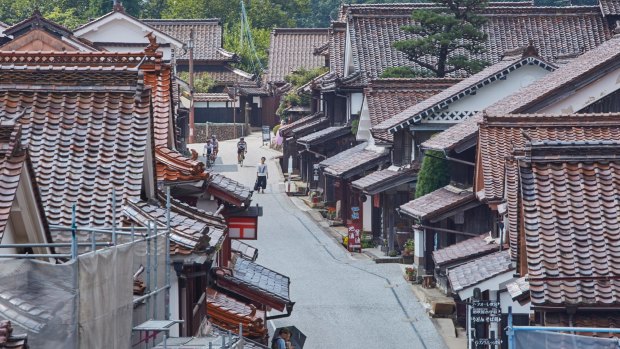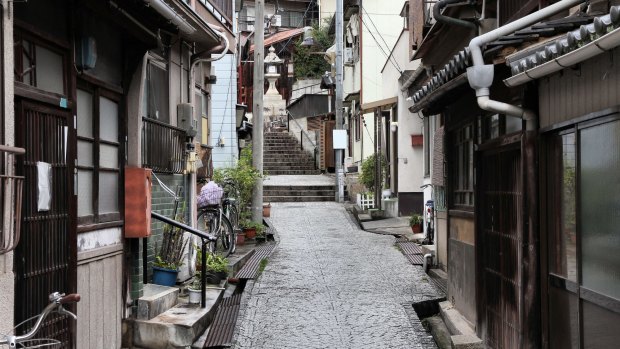This was published 6 years ago
Hiroshima, Japan: a calm complement to hectic Tokyo and Kyoto
By Amelia Lester

In Fukiya the elegant homes of merchants are impeccably maintained.Credit: JNTO
Hiroshima is a name synonymous with World War II, when it became the first city in history to be targeted by a nuclear weapon. A decade afterwards, the Peace Memorial Park and Museum opened in what was once Hiroshima's busiest commercial district, and tourism has increased steadily ever since, with 2 million visitors in 2016.
What is less well-known is that the surrounding countryside of Hiroshima prefecture, and adjacent Okayama, is some of Japan's prettiest and most serene. Located in the western part of Japan's main island of Honshu, the area is easy to access: Tokyo is 90 minutes away by plane, or slightly longer (and more expensive) by bullet train. Hiroshima is highly regarded by domestic tourists for its mild climate and natural beauty, set between the Chugoku mountains and the Seto Inland Sea. A recent trip to the area revealed a diversity of experiences, both outdoors and cultural, that made me think of Hiroshima prefecture as a supremely relaxing road trip for international visitors, and in particular, a calm complement to the hectic sightseeing and crowds of Tokyo and Kyoto.
An hour or so's drive from Hiroshima airport is Takehara, which means "bamboo-field city." (Takehara is also accessible by train from Hiroshima.) There are still large bamboo forests on the outskirts of the city, and the clean air and water has given rise to two other industries: salt, and sake.

Authentic Onomichi.Credit: Alamy
There's a lovely walk to be done through the Takehara Preservation District, known as "Little Kyoto" for its historic buildings, including some samurai residences, from the Edo through the Showa period. Narrow laneways lined with amber latticework and white plaster walls retain a distinct old-world air, and, at least on the rainy day I was there, the only company was a few photogenic cats lounging in Chinese-style diamond-shaped windows of merchant's houses. As in many Japanese towns, you can visit the carefully restored house of a famous potter, Mitsumoto; more unusual is the birthplace of the father of Japanese whiskey, Masataka, who founded Nikka Whisky Distilling. (An admired figure in Japan, he's the subject of a popular television drama which started in 2014 and is still running today.)
But for a more traditional tipple, there's sake. Fujii Shuzou is a brewery founded in 1863 and which is still run by the same family from one of Takehara's most beautiful buildings. Sake breweries used to be highly secretive places, but many these days open their doors and offer free tours of the magic made by yeast. Fujii's Ryusei brand is one of Japan's best, and was awarded the prize of best sake at the country's first-ever sake competition in 1907. Even if you're not sold on sake, the process of fermenting rice is fascinating, and, between the vats and the smoke and the gorgeous wooden buildings, undeniably atmospheric.
If you do develop a taste for Japanese rice wine, plan a trip to nearby Saijo in early October. That's the month when a new crop of rice is harvested and dried, and it's also when the Saijo Sake Festival, which in 2018 will celebrate its 29th birthday, takes place. At various spots around the Higashihiroshima city hall and Saijo train station, eight sake brewers welcome visitors for factory tours, and in Saijo Chuo Park, you can try 1000 kinds of sake from all over the country. Between the drum performances and udon stands, it's a surprisingly family-friendly day out, a reminder that for the Japanese, sake is an important cultural artefact more than a means of getting drunk. In fact, sake plays an important role in the Shinto religion. Offered at shrines in January as part of prayers for good health and good fortune, it's often referred to as the "wine of the gods," and empty sake barrels, called sakedaru, are donated by breweries to line the walls.
Another historic merchant town along the same train line, this time on a port, is Onomichi, which grew prosperous thanks to rice. It feels a little like an English seaside resort, with a promenade perfect for ice-cream eating, a sterling reputation for fresh seafood, and lots of chintzy souvenir shops. First, though, there's the hill behind the town to climb, at the summit of which you'll get a sense of the vastness of the Seto inland sea. (Keen bikers can ride along the coast on a well-maintained trail.) The vista reveals valleys filled with groves of oranges and lemons, which thrive in the Mediterranean climate, and on a clear day, you can see all the way out to Mukajima island in one direction, and Osaka in the other.
The descent into town winds past small temples and shrines set into the hillside. It must be even prettier in spring, when the cherry blossoms are out. Gradually the foliage gives way to charming alleys, where old terrace houses have been converted into cat cafes and honey shops. On the weekend I'm there, preparations for the biggest festival of the year are under way at one of the shrines, with women peeling eggs, cutting cabbage and stirring cauldrons of miso soup for a feast that evening to feed 250. (This sight makes me hungry, and for lunch I try a regional specialty: Onomichi ramen, made with fish stock and tender pork belly, served at most of the hotel restaurants along the water.)
An important nearby temple, Jyodoji, from the Edo period, boasts three landmarked national treasures: a devotion hall; a pagoda from the 14th century; and the grounds themselves, which maintain their original layout from the temple's founding in AD616. A Buddhist monk who looks to be in his late 20s takes a small group of us into the shrine. It's a rare and precious opportunity to see the ornate inner sanctum, filled with oranges, candles, mirrors, gold chandeliers, and an enormous lacquer cabinet with a statue of the goddess of mercy inside, shown only every 33 years. In his coffee-colored robes with a chartreuse collar, the monk kneels to ring a giant bell which echoes for a minute or more, rubs his prayer beads, and chants.
Next, he takes us into a tea room to teach the fundamentals of the matcha tea ceremony. We learn to whisk the powder – matcha is made from both the leaves and buds of the tea plant, which gives it that distinctively vegetal colour and taste – in an s-shape, before turning the cup 45 degrees, and taking three sips, with the last sip the smallest. "The main thing is to appreciate being all together and drinking tea," he says via a translator. "So don't worry too much."
The temple started offering talisman-making classes two years ago, and after tea and sweets are done, the monk takes us through to a wood-panelled room where he will help us forge our own. He explains that temples used to be community hubs, in part because they served as schools. In modern times, people tend to visit only for funerals, and not enough in daily life. Consequently, temples are experimenting with all sorts of outreach programs to attract visitors. Some sell incense, or offer historic costume rentals, but at Jyodoji, the good luck charm business is thriving. After a forging in iron, the monk gives me a charm which I must never remove from its silk pouch. He asks what I want it for, and I say for safe driving. It's still hanging in my car and has so far served me well.
The next day an entirely different part of Japan is on display when I visit Kojima, the birthplace of the Japanese denim industry. (It's a couple of hours' drive from Onomichi, and the rest of this itinerary, still hugging the inland sea, is technically in Okayama, not Hiroshima prefecture.) In recent years Japanese denim has become the world's most prestigious, but Kojima is a reminder that the industry dates to 1962, when Betty Smith became the first domestic manufacturer. Actually, the region's textile industry is even older, extending back to the Edo period, when it was discovered that although the soil was too salty for growing rice, it was extremely receptive to cotton. You can visit the Betty Smith Jeans Museum to learn perhaps more than you ever wanted to know about Japanese jeans-making. More appealingly, the shop offers custom-made pairs for a good price (starting at around $150).
The tourist town of Kurashiki, an hour's drive or so away, makes the most of its denim legacy with a very Instagrammable "denim burger." If you're not so enthused about the prospect of ingesting a large amount of blue food dye and standing in line for the privilege, I have good news: the town itself, which is centred around a preserved canal from the Edo period, is stunning, and well worth a visit. Kurashiki has been wealthy for a long time; its name can be loosely translated as "town of storehouses," because it was an important rice hub. In addition to taking lots of photos of the weeping willows which line the canal, there's the impressive Ohara Museum – Japan's oldest Western art collection – as well as an exquisitely restored merchant's house, and a former cotton mill factory converted into an extremely hip shopping district.
The final stop in this tour of picturesque countryside is the town of Fukiya, high in the mountains. The drive – there's no train here – is a winding one through dense forest, but you'll know you've arrived when you see the reddish roof tiles. This is known as the "town of Bengara," referring to a red earth pigment, no longer widely used, from copper, used to create the striking lacquer of the Edo period. (If you think Bengara sounds vaguely Indian, it's because it is: the red iron oxide is believed to have been brought to Japan from Bengal in the 16th century.)
There is something strangely beguiling about Fukiya. Up at 550 metres above sea level, it was once the largest copper mining town along the old Chugoku road, and the elegant homes of merchants with their bengara lattice, ornamental gables, and reddish roof tiles are impeccably maintained. Even the museum is old – it was completed in 1879 with the finest cherry wood the prosperous townspeople could buy. I didn't see any shops open while I was there – the opposite of bustling Kurashiki – but there were plenty of butterflies darting between alpine flowers. At the simple Laforest Fukiya, an unpretentious lodge on the outskirts of the town, dinner was humble but somehow sumptuous, a multi-course offering of local Okayama beef, river fish and regional sake. It was, as with many other moments along the Chugoku route, a singularly serene experience.
Amelia Lester travelled as a guest of Japan National Tourism Organisation.
TRIP NOTES
MORE
FLY
ANA and JAL fly daily from east coast ports to Tokyo, with onward domestic connections.
See ana.co.jp
STAY
In Onomachi, Minato No Yado offers accommodation in historic buildings restored by notable architects. Izumo House, set on the hillside of the town, features a beautiful first-floor tea room in the style of the Edo period. A boxed Japanese breakfast can be delivered to the house on request. See minatonoyado.jp/en/
TOUR
Traverse the mountains and bridges of the inland sea with Bike Tour Japan, which offers an eight-day tour including stops in Onomichi, Hiroshima, Takehara and some of the region's picturesque – and deserted – small islands. See biketourjapan.com
Sign up for the Traveller Deals newsletter
Get exclusive travel deals delivered straight to your inbox. Sign up now.